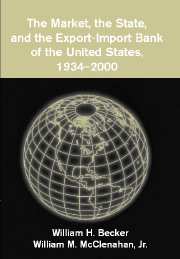Book contents
- Frontmatter
- Contents
- Preface and Acknowledgments
- Introduction
- 1 Setting a Flexible Course: The Export-Import Bank, 1934–1939
- 2 World War and Its Aftermath
- 3 Cold War and the Needs of a New Era, 1948–1961
- 4 Becoming “Two Institutions”
- 5 New Mandates and New Limits
- 6 Turmoil and Turning Points
- 7 A New Era and Its Challenges, the 1990s
- Epilogue
- Appendix A Board of Directors
- Appendix B Summary of Authorizations
- Appendix C Number of Authorizations
- Appendix D Charges Against Statutory Limitations on Total Activity
- Index
Epilogue
Published online by Cambridge University Press: 13 July 2009
- Frontmatter
- Contents
- Preface and Acknowledgments
- Introduction
- 1 Setting a Flexible Course: The Export-Import Bank, 1934–1939
- 2 World War and Its Aftermath
- 3 Cold War and the Needs of a New Era, 1948–1961
- 4 Becoming “Two Institutions”
- 5 New Mandates and New Limits
- 6 Turmoil and Turning Points
- 7 A New Era and Its Challenges, the 1990s
- Epilogue
- Appendix A Board of Directors
- Appendix B Summary of Authorizations
- Appendix C Number of Authorizations
- Appendix D Charges Against Statutory Limitations on Total Activity
- Index
Summary
To mark sixty-five years of work, the Washington-based Institute for International Economics (IIE), with the full support of the Bank, sponsored a conference in May 2000 to assess Ex-Im's effectiveness and to explore its role in the twenty-first century. While the theme of the conference was looking toward a new century, conference participants nevertheless also focused heavily on the Bank's situation at the end of the 1990s. In fact, the tenor of the conference – and the book made up of selected papers published in 2001 – was in large measure one of taking stock. To plan for the future, one needed to put the recent past into perspective. Thus, the conference presentations generally addressed the challenges the Bank faced at the end of the century. Together these challenges represented, as was so often the case in the past, the need for the Bank to determine how to adjust its internal operations and policies to yet another set of shifts in the public and private, domestic and international, environments in which it operated. In many respects, of course, the process of adjustment was already underway at the time of the meetings in Washington.
But, as the century ended, it was not entirely clear how the Bank would ultimately respond to some of the other challenges that it faced. This, of course, was one of the reasons for the conference.
- Type
- Chapter
- Information
- Publisher: Cambridge University PressPrint publication year: 2003

